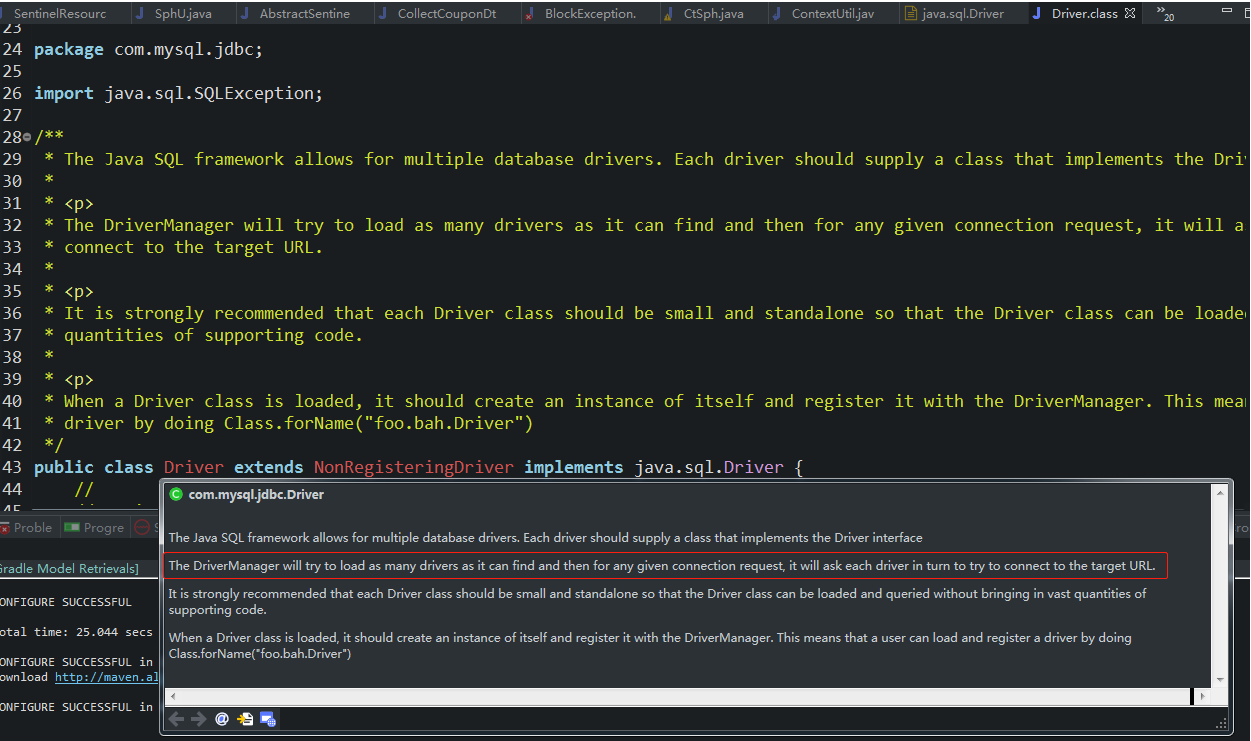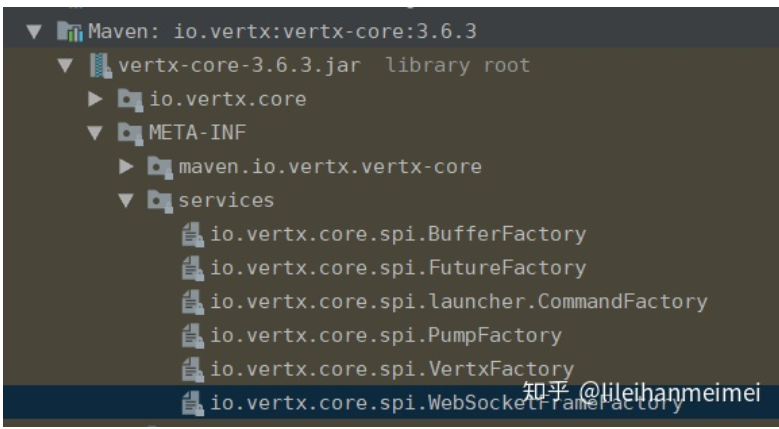前言:
SPI是jdk内置的服务发现机制, 全称叫Service Provider Interface.
SPI的工作原理, 就是ClassPath路径下的META-INF/services文件夹中, 以接口的全限定名来命名文件名, 文件里面写该接口的实现。 然后再资源加载的方式,读取文件的内容(接口实现的全限定名), 然后再去加载类。
SPI可以很灵活的让接口和实现分离, 让api提供者只提供接口, 第三方来实现。
这一机制为很多框架的扩展提供了可能,比如在 Dubbo、JDBC、SpringBoot 中都使用到了SPI机制。虽然他们之间的实现方式不同,但原理都差不多。今天我们就来看看,SPI到底是何方神圣,在众多开源框架中又扮演了什么角色。
一、JDK中的SPI
我们先从JDK开始,通过一个很简单的例子来看下它是怎么用的。
1、小栗子
首先,我们需要定义一个接口,SpiService
package com.dxz.jdk.spi; public interface SpiService { void println(); }
然后,定义一个实现类,没别的意思,只做打印。
package com.dxz.jdk.spi; public class SpiServiceImpl implements SpiService { @Override public void println() { System.out.println("------SPI DEMO-------"); } }
最后呢,要在resources路径下配置添加一个文件。文件名字是接口的全限定类名,内容是实现类的全限定类名,多个实现类用换行符分隔。
文件内容就是实现类的全限定类名:
2、测试
然后我们就可以通过 ServiceLoader.load 方法拿到实现类的实例,并调用它的方法。
public static void main(String[] args){ ServiceLoader<SpiService> load = ServiceLoader.load(SpiService.class); Iterator<SpiService> iterator = load.iterator(); while (iterator.hasNext()){ SpiService service = iterator.next(); service.println(); } }
3、源码分析
首先,我们先来了解下 ServiceLoader,看看它的类结构。
public final class ServiceLoader<S> implements Iterable<S>{ //配置文件的路径 private static final String PREFIX = "META-INF/services/"; //加载的服务类或接口 private final Class<S> service; //已加载的服务类集合 private LinkedHashMap<String,S> providers = new LinkedHashMap<>(); //类加载器 private final ClassLoader loader; //内部类,真正加载服务类 private LazyIterator lookupIterator; }
当我们调用 load 方法时,并没有真正的去加载和查找服务类。而是调用了 ServiceLoader 的构造方法,在这里最重要的是实例化了内部类 LazyIterator ,它才是接下来的主角。
private ServiceLoader(Class<S> svc, ClassLoader cl) { //要加载的接口 service = Objects.requireNonNull(svc, "Service interface cannot be null"); //类加载器 loader = (cl == null) ? ClassLoader.getSystemClassLoader() : cl; //访问控制器 acc = (System.getSecurityManager() != null) ? AccessController.getContext() : null; //先清空 providers.clear(); //实例化内部类 LazyIterator lookupIterator = new LazyIterator(service, loader); }
查找实现类和创建实现类的过程,都在 LazyIterator 完成。当我们调用 iterator.hasNext和iterator.next 方法的时候,实际上调用的都是 LazyIterator 的相应方法。
public Iterator<S> iterator() { return new Iterator<S>() { public boolean hasNext() { return lookupIterator.hasNext(); } public S next() { return lookupIterator.next(); } ....... }; }
所以,我们重点关注 lookupIterator.hasNext() 方法,它最终会调用到 hasNextServicez ,在这里返回实现类名称。
private class LazyIterator implements Iterator<S>{ Class<S> service; ClassLoader loader; Enumeration<URL> configs = null; Iterator<String> pending = null; String nextName = null; private boolean hasNextService() { //第二次调用的时候,已经解析完成了,直接返回 if (nextName != null) { return true; } if (configs == null) { //META-INF/services/ 加上接口的全限定类名,就是文件服务类的文件 //META-INF/services/com.viewscenes.netsupervisor.spi.SPIService String fullName = PREFIX + service.getName(); //将文件路径转成URL对象 configs = loader.getResources(fullName); } while ((pending == null) || !pending.hasNext()) { //解析URL文件对象,读取内容,最后返回 pending = parse(service, configs.nextElement()); } //拿到第一个实现类的类名 nextName = pending.next(); return true; } }
然后当我们调用 next() 方法的时候,调用到 lookupIterator.nextService 。它通过反射的方式,创建实现类的实例并返回。
private S nextService() { //全限定类名 String cn = nextName; nextName = null; //创建类的Class对象 Class<?> c = Class.forName(cn, false, loader); //通过newInstance实例化 S p = service.cast(c.newInstance()); //放入集合,返回实例 providers.put(cn, p); return p; }
到这为止,已经获取到了类的实例。
二、JDBC中的应用
我们开头说,SPI机制为很多框架的扩展提供了可能,其实JDBC就应用到了这一机制。
在以前,需要先设置数据库驱动的连接,再通过 DriverManager.getConnection 获取一个 Connection 。
String url = "jdbc:mysql:///consult?serverTimezone=UTC"; String user = "root"; String password = "root"; Class.forName("com.mysql.jdbc.Driver"); Connection connection = DriverManager.getConnection(url, user, password);
而现在,设置数据库驱动连接,这一步骤就不再需要,那么它是怎么分辨是哪种数据库的呢?答案就在SPI。
1、加载
下图mysql Driver的实例。 com.mysql.cj.jdbc.Driver就是Driver的实现。

mysql驱动为例

mysql Driver实现类

Driver接口上的一段注释。
DriverManager将尝试加载尽可能多的驱动程序。
我们把目光回到 DriverManager 类,它在静态代码块里面做了一件比较重要的事。很明显,它已经通过SPI机制, 把数据库驱动连接初始化了。
public class DriverManager { static { loadInitialDrivers(); println("JDBC DriverManager initialized"); } }
接下来我们去DriverManger上看看是如何加载Driver接口的实现类的。
public class DriverManager { /** * Load the initial JDBC drivers by checking the System property * jdbc.properties and then use the {@code ServiceLoader} mechanism */ static { loadInitialDrivers(); println("JDBC DriverManager initialized"); } private static void loadInitialDrivers() { AccessController.doPrivileged(new PrivilegedAction<Void>() { public Void run() { ServiceLoader<Driver> loadedDrivers = ServiceLoader.load(Driver.class); Iterator<Driver> driversIterator = loadedDrivers.iterator(); try{ while(driversIterator.hasNext()) { driversIterator.next(); } } catch(Throwable t) { } return null; } }); }
在DriverManger类初始化的时候, 调用loadInitialDrivers方法。
具体过程还得看 loadInitialDrivers ,它在里面查找的是Driver接口的服务类,所以它的文件路径就是:
META-INF/services/java.sql.Driver
在loadInitialDrivers方法中,
private static void loadInitialDrivers() { AccessController.doPrivileged(new PrivilegedAction<Void>() { public Void run() { //很明显,它要加载Driver接口的服务类,Driver接口的包为:java.sql.Driver //所以它要找的就是META-INF/services/java.sql.Driver文件 ServiceLoader<Driver> loadedDrivers = ServiceLoader.load(Driver.class); Iterator<Driver> driversIterator = loadedDrivers.iterator(); try{ //查到之后创建对象 while(driversIterator.hasNext()) { driversIterator.next();//当调用next方法时,就会创建这个类的实例。它就完成了一件事,向 DriverManager 注册自身的实例。 } } catch(Throwable t) { // Do nothing } return null; } }); }
这段代码是实现SPI的关键, 真是这个ServiceLoader类去实现SPI的。 那么下面就分析分析ServiceLoader的代码, 看看是如何实现SPI的。
package java.util; public final class ServiceLoader<S> implements Iterable<S> { public static <S> ServiceLoader<S> load(Class<S> service) { ClassLoader cl = Thread.currentThread().getContextClassLoader(); return ServiceLoader.load(service, cl); } //其中service就是要加载实现类对应的接口, loader就是用该加载器去加载对应的实现类 public static <S> ServiceLoader<S> load(Class<S> service, ClassLoader loader){ return new ServiceLoader<>(service, loader); } }
先调用ServiceLoader类的静态方法load, 然后根据当前线程的上下文类加载器,创建一个ServiceLoader实例。 关于类加载器,上篇文章刚分析完。
private static final String PREFIX = "META-INF/services/"; public void reload() { providers.clear(); lookupIterator = new LazyIterator(service, loader); } private ServiceLoader(Class<S> svc, ClassLoader cl) { service = Objects.requireNonNull(svc, "Service interface cannot be null"); loader = (cl == null) ? ClassLoader.getSystemClassLoader() : cl; acc = (System.getSecurityManager() != null) ? AccessController.getContext() : null; reload(); }
创建ServiceLoader实例的时候,接着创建一个Iterator实现类。 接下来这个Iterator分析的重点。基本所有的加载类的实现逻辑都在里面。
其中ServiceLoader类中一个常量的定义是关键的。 前面说过,我们service的实现类在放在哪, 就是这里写死的常量路径。
//这里先介绍Iterator的变量,先大概有个印象。 private class LazyIterator implements Iterator<S> { //service, loader前面介绍过了。 Class<S> service; ClassLoader loader; Enumeration<URL> configs = null; Iterator<String> pending = null; String nextName = null; public boolean hasNext() { //省略权限相关代码 return hasNextService(); } private boolean hasNextService() { //一开始nextName肯定为空 if (nextName != null) { return true; } //一开始configs也肯定为空 if (configs == null) { try { //PREFIX = META-INF/services/ //以mysql为例,就是 META-INF/services/java.sql.Driver String fullName = PREFIX + service.getName(); if (loader == null) configs = ClassLoader.getSystemResources(fullName); //loader去加载这个classpath下文件。 //这里很有可能返回的是多个文件的资源, //例如一个项目下既有mysql驱动, 也有sql server驱动等 //所以返回的是一个枚举类型。 else configs = loader.getResources(fullName); } catch (IOException x) { fail(service, "Error locating configuration files", x); } } while ((pending == null) || !pending.hasNext()) { if (!configs.hasMoreElements()) { return false; } //然后根据加载出来的资源,解析一个文件中的内容。放到Iterator实现类中 pending = parse(service, configs.nextElement()); } //这里next返回的就是文件一行的内容,一般一行对应一个接口的实现类。 //一个接口放多行,就可以有多个接口实现类中。 nextName = pending.next(); return true; } }
configs变量,就对应service文件。 是个枚举, 就是说可以定义多个service文件。
pending 变量: 就对应configs中, service文件解析出来的一行有效内容,即一个实现类的全限定类名称。
parse方法就是简单,不是重点。这里就略过了。就是读取service文件中读取,一行就是一个nextName,然后遇到“#“就跳过“#”后面的内容。所以service文件可以用“#”作为注释。 直到遇到空行,解析结束。
LazyIterator类中的hasNext方法就分析完了。 使用classLoader.getResources方法加载service文件。我看了下getResources方法,并一定是加载classpath下的资源,得根据classLoader来解决。不过绝大多数情况下,都是classpath的资源。这里为了好理解,就理解成classpath下的资源。
接着分析LazyIterator#next方法。
public S next() { //删除权限相关代码 return nextService(); } private S nextService() { if (!hasNextService()) throw new NoSuchElementException(); //这个nextName前面分析过了 String cn = nextName; nextName = null; Class<?> c = null; try { //加载类,且不初始化 c = Class.forName(cn, false, loader); } catch (ClassNotFoundException x) { fail(service, "Provider " + cn + " not found"); } if (!service.isAssignableFrom(c)) { fail(service, "Provider " + cn + " not a subtype"); } try { //类型判断 S p = service.cast(c.newInstance()); //最后放到ServiceLoader实例变量Map中,缓存起来,下次直接使用 providers.put(cn, p); return p; } catch (Throwable x) { fail(service, "Provider " + cn + " could not be instantiated", x); } throw new Error(); // This cannot happen }
next方法就比较简单了,根据前面解析出来的nextName(接口实现类的全限定名称),用Class.forName创建对应的Class对象。
3、创建Connection
DriverManager.getConnection() 方法就是创建连接的地方,它通过循环已注册的数据库驱动程序,调用其connect方法,获取连接并返回。
private static Connection getConnection(String url, Properties info, Class<?> caller) throws SQLException { //registeredDrivers中就包含com.mysql.cj.jdbc.Driver实例 for(DriverInfo aDriver : registeredDrivers) { if(isDriverAllowed(aDriver.driver, callerCL)) { try { //调用connect方法创建连接 Connection con = aDriver.driver.connect(url, info); if (con != null) { return (con); } }catch (SQLException ex) { if (reason == null) { reason = ex; } } } else { println("skipping: " + aDriver.getClass().getName()); } } }
4、扩展
既然我们知道JDBC是这样创建数据库连接的,我们能不能再扩展一下呢?如果我们自己也创建一个 java.sql.Driver 文件,自定义实现类MySQLDriver,那么,在获取连接的前后就可以动态修改一些信息。
还是先在项目resources下创建文件,文件内容为自定义驱动类 com.jcc.java.spi.domyself.MySQLDriver

我们的 MySQLDriver 实现类,继承自MySQL中的 NonRegisteringDriver ,还要实现 java.sql.Driver 接口。这样,在调用connect方法的时候,就会调用到此类,但实际创建的过程还靠MySQL完成。
public class MySQLDriver extends NonRegisteringDriver implements Driver{ static { try { DriverManager.registerDriver(new MySQLDriver()); } catch (SQLException e) { e.printStackTrace(); } } public MySQLDriver() throws SQLException {} @Override public Connection connect(String url, Properties info) throws SQLException { System.out.println("准备创建数据库连接.url:"+url); System.out.println("JDBC配置信息:"+info); //重置配置 info.setProperty("user", "root"); Connection connection = super.connect(url, info); System.out.println("数据库连接创建完成!"+connection.toString()); return connection; } }
这样的话,当我们获取数据库连接的时候,就会调用到这里。
--------------------输出结果--------------------- 准备创建数据库连接.url:jdbc:mysql:///consult?serverTimezone=UTC JDBC配置信息:{user=root, password=root} 数据库连接创建完成!com.mysql.cj.jdbc.ConnectionImpl@7cf10a6f
三、SpringBoot中的应用
Spring Boot提供了一种快速的方式来创建可用于生产环境的基于Spring的应用程序。它基于Spring框架,更倾向于约定而不是配置,并且旨在使您尽快启动并运行。
即便没有任何配置文件,SpringBoot的Web应用都能正常运行。这种神奇的事情,SpringBoot正是依靠自动配置来完成。
说到这,我们必须关注一个东西: SpringFactoriesLoader,自动配置就是依靠它来加载的。
1、配置文件
SpringFactoriesLoader 来负责加载配置。我们打开这个类,看到它加载文件的路径是: META-INF/spring.factories
笔者在项目中搜索这个文件,发现有4个Jar包都包含它:
- List itemspring-boot-2.1.9.RELEASE.jar
- spring-beans-5.1.10.RELEASE.jar
- spring-boot-autoconfigure-2.1.9.RELEASE.jar
- mybatis-spring-boot-autoconfigure-2.1.0.jar
那么它们里面都是些啥内容呢?其实就是一个个接口和类的映射。在这里笔者就不贴了,有兴趣的小伙伴自己去看看。
比如在SpringBoot启动的时候,要加载所有的 ApplicationContextInitializer ,那么就可以这样做:
SpringFactoriesLoader.loadFactoryNames(ApplicationContextInitializer.class, classLoader)
2、加载文件
loadSpringFactories 就负责读取所有的 spring.factories 文件内容。
private static Map<String, List<String>> loadSpringFactories(@Nullable ClassLoader classLoader) { MultiValueMap<String, String> result = cache.get(classLoader); if (result != null) { return result; } try { //获取所有spring.factories文件的路径 Enumeration<URL> urls = lassLoader.getResources("META-INF/spring.factories"); result = new LinkedMultiValueMap<>(); while (urls.hasMoreElements()) { URL url = urls.nextElement(); //加载文件并解析文件内容 UrlResource resource = new UrlResource(url); Properties properties = PropertiesLoaderUtils.loadProperties(resource); for (Map.Entry<?, ?> entry : properties.entrySet()) { String factoryClassName = ((String) entry.getKey()).trim(); for (String factoryName : StringUtils.commaDelimitedListToStringArray((String) entry.getValue())) { result.add(factoryClassName, factoryName.trim()); } } } cache.put(classLoader, result); return result; } catch (IOException ex) { throw new IllegalArgumentException("Unable to load factories from location [" + FACTORIES_RESOURCE_LOCATION + "]", ex); } }
可以看到,它并没有采用JDK中的SPI机制来加载这些类,不过原理差不多。都是通过一个配置文件,加载并解析文件内容,然后通过反射创建实例。
3、参与其中
假如你希望参与到 SpringBoot 初始化的过程中,现在我们又多了一种方式。
我们也创建一个 spring.factories 文件,自定义一个初始化器。
org.springframework.context.ApplicationContextInitializer=com.youyouxunyin.config.context.MyContextInitializer
然后定义一个MyContextInitializer类
public class MyContextInitializer implements ApplicationContextInitializer { @Override public void initialize(ConfigurableApplicationContext configurableApplicationContext) { System.out.println(configurableApplicationContext); } }
四、Dubbo中的应用
我们熟悉的Dubbo也不例外,它也是通过 SPI 机制加载所有的组件。同样的,Dubbo 并未使用 Java 原生的 SPI 机制,而是对其进行了增强,使其能够更好的满足需求。在 Dubbo 中,SPI 是一个非常重要的模块。基于 SPI,我们可以很容易的对 Dubbo 进行拓展。
关于原理,如果有小伙伴不熟悉,可以参阅笔者文章:
它的使用方式同样是在 META-INF/services 创建文件并写入相关类名。
关于使用场景,可以参考: SpringBoot+Dubbo集成ELK实战
五、sentinel中的应用
通过SPI机制将META-INFO/servcie下配置好的默认责任链构造这加载出来,然后调用其builder()方法进行构建调用链
public final class SlotChainProvider { private static volatile SlotChainBuilder slotChainBuilder = null; /** * The load and pick process is not thread-safe, but it's okay since the method should be only invoked * via {@code lookProcessChain} in {@link com.alibaba.csp.sentinel.CtSph} under lock. * * @return new created slot chain */ public static ProcessorSlotChain newSlotChain() { if (slotChainBuilder != null) { return slotChainBuilder.build(); } // Resolve the slot chain builder SPI. slotChainBuilder = SpiLoader.of(SlotChainBuilder.class).loadFirstInstanceOrDefault(); if (slotChainBuilder == null) { // Should not go through here. RecordLog.warn("[SlotChainProvider] Wrong state when resolving slot chain builder, using default"); slotChainBuilder = new DefaultSlotChainBuilder(); } else { RecordLog.info("[SlotChainProvider] Global slot chain builder resolved: {}", slotChainBuilder.getClass().getCanonicalName()); } return slotChainBuilder.build(); } private SlotChainProvider() {} }
SpiLoader.of()
public static <T> SpiLoader<T> of(Class<T> service) { AssertUtil.notNull(service, "SPI class cannot be null"); AssertUtil.isTrue(service.isInterface() || Modifier.isAbstract(service.getModifiers()), "SPI class[" + service.getName() + "] must be interface or abstract class"); String className = service.getName(); SpiLoader<T> spiLoader = SPI_LOADER_MAP.get(className); if (spiLoader == null) { synchronized (SpiLoader.class) { spiLoader = SPI_LOADER_MAP.get(className); if (spiLoader == null) { SPI_LOADER_MAP.putIfAbsent(className, new SpiLoader<>(service)); spiLoader = SPI_LOADER_MAP.get(className); } } } return spiLoader; }
@Spi(isDefault = true) public class DefaultSlotChainBuilder implements SlotChainBuilder { @Override public ProcessorSlotChain build() { ProcessorSlotChain chain = new DefaultProcessorSlotChain(); List<ProcessorSlot> sortedSlotList = SpiLoader.of(ProcessorSlot.class).loadInstanceListSorted(); for (ProcessorSlot slot : sortedSlotList) { if (!(slot instanceof AbstractLinkedProcessorSlot)) { RecordLog.warn("The ProcessorSlot(" + slot.getClass().getCanonicalName() + ") is not an instance of AbstractLinkedProcessorSlot, can't be added into ProcessorSlotChain"); continue; } chain.addLast((AbstractLinkedProcessorSlot<?>) slot); } return chain; } }
责任链同样是由spi机制加载出来的,上面的加载只会在第一次使用的时候加载,然后缓存到内从后,以后直接取即可。
至此,SPI机制的实现原理就分析完了。 虽然SPI我们日常开发中用的很少,但是至少了解了解还是有必要的。 例如: 一些框架实现中一般都会用到SPI机制。

vert.x内部也是大量使用SPI
转自:https://zhuanlan.zhihu.com/p/59546945
https://blog.csdn.net/KingJin_CSDN_/article/details/103667359